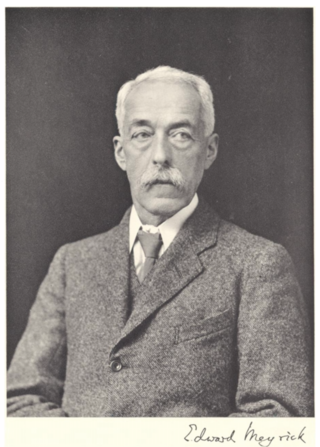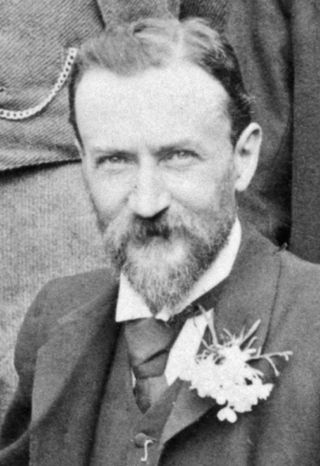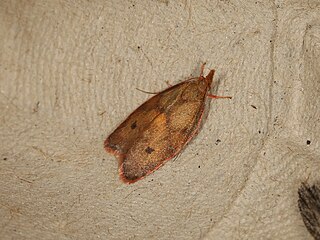
Lepidoptera or lepidopterans is an order of winged insects that includes butterflies and moths. About 180,000 species of the Lepidoptera have been described, representing 10% of the total described species of living organisms, making it the second largest insect order with 126 families and 46 superfamilies, and one of the most widespread and widely recognizable insect orders in the world.

The Zygaenidae moths are a family of Lepidoptera. The majority of zygaenids are tropical, but they are nevertheless quite well represented in temperate regions. Some of the 1000 or so species are commonly known as burnet or forester moths, often qualified by the number of spots, although other families also have 'foresters'. They are also sometimes called smoky moths.

Edward Meyrick was an English schoolmaster and amateur entomologist. He was an expert on microlepidoptera and some consider him one of the founders of modern microlepidoptera systematics.

Lophocoronoidea is a superfamily of insects in the order Lepidoptera. There is a single extant genus, Lophocorona, in the family Lophocoronidae. These are small, primitive nocturnal moths restricted to Australia whose biology is largely unknown.

Arthur Gardiner Butler F.L.S., F.Z.S. was an English entomologist, arachnologist and ornithologist. He worked at the British Museum on the taxonomy of birds, insects, and spiders.

The Coleophoridae are a family of small moths, belonging to the huge superfamily Gelechioidea. Collectively known as case-bearers, casebearing moths or case moths, this family is represented on all continents, but the majority are found in temperate areas of the Northern Hemisphere. They are most common in the Palearctic, and rare in sub-Saharan Africa, South America, and Australia; consequently, they probably originated in northern Eurasia. They are relatively common in houses, they seek out moist areas to rest and procreate.

The Arctiini are a tribe of tiger moths in the family Erebidae.

Nepticulidae is a family of very small moths with a worldwide distribution. They are characterised by eyecaps over the eyes. These pigmy moths or midget moths, as they are commonly known, include the smallest of all living moths, with a wingspan that can be as little as 3 mm in the case of the European pigmy sorrel moth, but more usually 3.5–10 mm. The wings of adult moths are narrow and lanceolate, sometimes with metallic markings, and with the venation very simplified compared to most other moths.
Anomoses hylecoetes is a species of primitive hepialoid moth endemic to Queensland and New South Wales, Australia . It is the only species in its genus Anomoses, which is the only genus in the family Anomosetidae.

Epermeniidae or the fringe-tufted moths is a family of insects in the lepidopteran order with about 14 genera. Previously they have been divided in two subfamilies Epermeniinae and Ochromolopinae but this is no longer maintained since the last group is probably hierarchically nested within the first. They are presently placed in their own superfamily but have previously been placed among the Yponomeutoidea or Copromorphoidea with which they share some features. Their systematic placement among the apoditrysian group "Obtectomera" is however uncertain. They show some morphological similarities to the "plume moths", for example the wing fringe has similar groups of scales. There are also some similarities to Schreckensteinioidea, for example spiny legs and at least in some species an open-network cocoon. The genus Thambotricha from New Zealand may be the sister group of all other extant members. The most important genera are Epermenia, Ochromolopis and Gnathifera. The group has been extensively revised and catalogued by Dr Reinhard Gaedike.
Agathiphaga is a genus of moths, known as kauri moths. and is the only living genus in the family Agathiphagidae. This caddisfly-like lineage of primitive moths was first reported by Lionel Jack Dumbleton in 1952, as a new genus of Micropterigidae.

The Autostichinae are a subfamily of moths in the superfamily Gelechioidea. Like their relatives therein, their exact relationships are not yet very well resolved. The present lineage was often included in the concealer moth family (Oecophoridae), but alternatively it is united with the Symmocidae sensu stricto to form an expanded family Autostichidae.
Victor Gurney Logan Van Someren was a zoologist and entomologist. Van Someren was born in Australia. He attended George Watson's College and studied zoology at University of Edinburgh. He was also a dentist. Van Someren moved to Kenya in 1912 and lived in Nairobi. He was in the East Africa and Uganda Natural History Society and became Honorary Secretary. In 1930 he became Curator of the Coryndon Museum. Van Someren named a number of bird and butterfly species.

Enchocrates is a genus of moths of the family Oecophoridae.

Epermenia is a genus of moths in the family Epermeniidae. The genus was first described by Jacob Hübner in 1825.
Enchocrates glaucopis is a moth in the family Depressariidae. It was described by Edward Meyrick in 1883. It is found in Australia, where it has been recorded from the south-east of the country.
Enchocrates phaedryntis is a moth in the family Depressariidae. It was described by Edward Meyrick in 1888. It is found in Australia, where it has been recorded from Western Australia.
Enchocrates picrophylla is a moth in the family Depressariidae. It was described by Edward Meyrick in 1886. It is found in Australia, where it has been recorded from South Australia and New South Wales.
Enchocrates vesperascens is a moth in the family Depressariidae. It was described by Edward Meyrick in 1921. It is found in Australia, where it has been recorded from South Australia.










